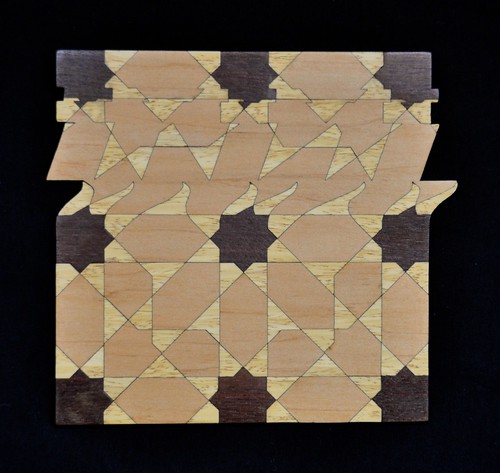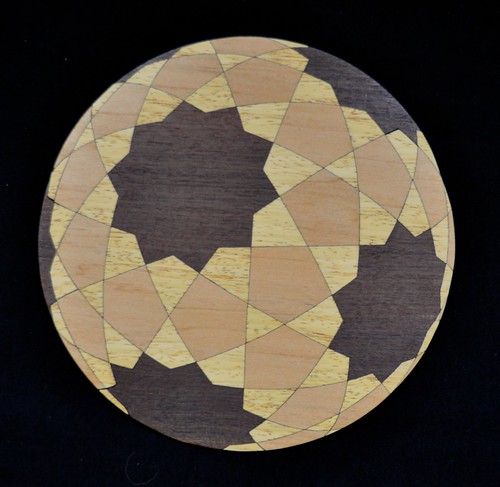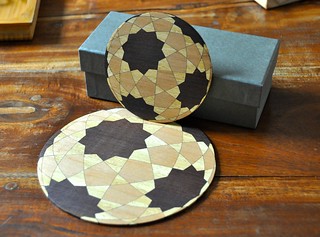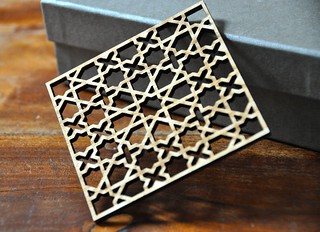Laser-cut Islamic marquetry
It took a while after arriving in London before I realized that I could gain access to the Institute of Making. I had initially assumed that because I wasn’t a student at UCL, and had no permanent affiliation with the university, I couldn’t become a member. As it turned out, all I needed was a userid in the university’s identity system, which was easy enough to obtain.
The Institute, which has only been open for a year or two, is a comprehensive maker space nestled into the ground floor of the very building that houses the UCL CS department. Almost everything in it is freely usable by members. It’s a lot like the increasingly common hacklabs / makespaces / etc., but better funded and better organized. Also, I hate to say this, but there’s less Attitude among the members — I find the environment much more congenial and supportive than that of the London Hackspace, though perhaps that’s due to a small number of boors in the Hackspace during my brief time there.
But on to marquetry. The Institute offers a laser cutter, and I’ve long been hoping to play around with assembling laser-cut wooden pieces, inspired in large part by the Escher-like compositions created by Kevin Lee. I created a few pieces that use Islamic star patterns as a departure point, but that play with the standard representation of these patterns in a couple of different ways.
To begin with, I tried to assemble a straight-ahead pattern, a standard design based on a 16-pointed star.
I made a lot of mistakes in assembling this first piece, which is, of course, the point. For anyone thinking about creating laser-cut parquetry, here are some observations:
- All the wooden pieces except the central star were oriented in the laser bed so that the wood grain lines up with the symmetry axes of the design. I’m not sure that works — the many grain orientations make the composition look busy and fussy.
- The central star should have been oriented so that its grain was horizontal or vertical. It’s through pure carelessness that it’s at some other angle.
- The surrounding frame was unnecessary, and if I were to recreate this piece I’d probably leave the frame out.
- Kerf is the bogeyman of laser cutting. The laser beam is very thin, but not infinitely thin. It’s crucial to measure the beam’s width and offset cutting paths by (half) that amount. But it’s best to adjust paths by less than the actual kerf, just to allow some slack. In other words, choosing the right offset amount for cutting paths is a Black Art.
- Even worse, the kerf varies across the thickness of the material, as the beam spreads out away from its focal distance. As a result, even though most of the individual shapes in this composition are mirror-symmetric, in practice they have a definite “front” and “back”. It’s best to assemble the pieces so that they’re all the same way up. (Mathematicians: note that this design is mostly two-colourable. Yes, you might be able to get away with alternating front and back sides in such compositions, though not if you want a frame like in the design above.)
- I glued the pieces together by applying wood glue along edges with a toothpick, and holding pieces together until they stuck enough to continue. That’s a terrible method, but I don’t have anything better to suggest. Obviously gluing pieces to a single backing sheet would be easier.
- I didn’t choose my pieces of wood (3mm walnut, bass and obeche veneers) very carefully, and so I don’t have as much grain or contrast as I would like.
- Once glued, the piece is sanded (something like P120 followed by P220) and treated with Danish Oil.
With the lessons learned from that first experiment, I created two more ambitious pieces.
The first, Glitch, pays homage to Glitch Art, a style of digital art in which (for example) JPEG images are manipulated at the bit level to produce unexpected distortions of shape and colour. I experimented with a geometric interpretation of glitch, which I thought would work well when combined with the organic craft-like appearance of marquetry. The result is reasonably interesting, though if I did it again I might preserve the boundaries between Zellij tiles, even when they could be cut as a single fused piece of wood. It was only last week, months after creating this piece, that I happened to discover the work of Faig Ahmed, who created a series of incredibly beautiful glitched-out Persian carpets.
The second piece, Flattened Sphere, is a spherical Islamic star pattern that has been projected flat and captured in wood. This design works quite well; apparently the trompe l’oeil effect is convincing.
This artwork was interesting to assemble. Although there are only four different tile shapes on the surface of the sphere, when projected every element becomes unique. It’s an interesting puzzle to put them together into the one intended configuration, especially the hopelessly thin pieces along the edges. Of course, you can make the thin pieces even thinner by cutting a second, smaller design, intended for use as a coaster.
Of course, I’ve still got lots of wood. Some of it will necessarily be used to create laser-cut display stands for Glitch and Flattened Sphere, for their appearance at the Bridges 2014 art exhibition. I’m not sure what I’ll do with the rest. I already cut a small wooden screen, just for fun.
By the way, I’m not sure whether these artworks are more accurately called “parquetry” or “marquetry”. Apparently, marquetry usually denotes a single, often figurative composition, whereas parquetry is reserved for repeating geometric patterns. Glitch and Flattened Sphere are both based on repeating patterns, but modified into one-off compositions. For that reason, I decided to go with marquetry in this post, but I’ll probably use the terms interchangeably in practice.





Leave a Reply